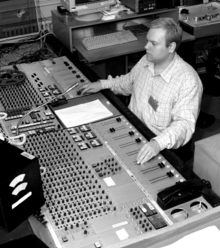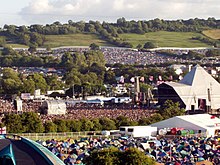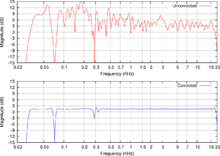
An audio engineer (also known as a sound engineer or recording engineer)[1][2] helps to produce a recording or a live performance, balancing and adjusting sound sources using equalization, dynamics processing and audio effects, mixing, reproduction, and reinforcement of sound. Audio engineers work on the "technical aspect of recording—the placing of microphones, pre-amp knobs, the setting of levels. The physical recording of any project is done by an engineer…"[3]
Sound engineering is increasingly seen as a creative profession where musical instruments and technology are used to produce sound for film, radio, television, music and video games.[4] Audio engineers also set up, sound check and do live sound mixing using a mixing console and a sound reinforcement system for music concerts, theatre, sports games and corporate events.
Alternatively, audio engineer can refer to a scientist or professional engineer who holds an engineering degree and who designs, develops and builds audio or musical technology working under terms such as electronic/electrical engineering or (musical) signal processing.[5]
Research and development audio engineers invent new technologies, audio software, equipment and techniques, to enhance the process and art of audio engineering.[6] They might design acoustical simulations of rooms, shape algorithms for audio signal processing, specify the requirements for public address systems, carry out research on audible sound for video game console manufacturers, and other advanced fields of audio engineering. They might also be referred to as acoustic engineers.[7][8]
|
See also: Category:Audio engineering schools |
Audio engineers working in research and development may come from backgrounds such as acoustics, computer science, broadcast engineering, physics, acoustical engineering, electrical engineering and electronics. Audio engineering courses at university or college fall into two rough categories: (i) training in the creative use of audio as a sound engineer, and (ii) training in science or engineering topics, which then allows students to apply these concepts while pursuing a career developing audio technologies. Audio training courses provide knowledge of technologies and their application to recording studios and sound reinforcement systems, but do not have sufficient mathematical and scientific content to allow someone to obtain employment in research and development in the audio and acoustic industry.[9]

Audio engineers in research and development usually possess a bachelor's degree, master's degree or higher qualification in acoustics, physics, computer science or another engineering discipline. They might work in acoustic consultancy, specializing in architectural acoustics.[10] Alternatively they might work in audio companies (e.g. headphone manufacturer), or other industries that need audio expertise (e.g., automobile manufacturer), or carry out research in a university. Some positions, such as faculty (academic staff) require a Doctor of Philosophy. In Germany a Toningenieur is an audio engineer who designs, builds and repairs audio systems.[citation needed]
The listed subdisciplines are based on PACS (Physics and Astronomy Classification Scheme) coding used by the Acoustical Society of America with some revision.[11]
Audio engineers develop audio signal processing algorithms to allow the electronic manipulation of audio signals. These can be processed at the heart of much audio production such as reverberation, Auto-Tune or perceptual coding (e.g. MP3 or Opus). Alternatively, the algorithms might perform echo cancellation, or identify and categorize audio content through music information retrieval or acoustic fingerprint.[12]

Architectural acoustics is the science and engineering of achieving a good sound within a room.[13] For audio engineers, architectural acoustics can be about achieving good speech intelligibility in a stadium or enhancing the quality of music in a theatre.[14] Architectural Acoustic design is usually done by acoustic consultants.[10]
|
See also: Sound reinforcement system |

Electroacoustics is concerned with the design of headphones, microphones, loudspeakers, sound reproduction systems and recording technologies.[8] Examples of electroacoustic design include portable electronic devices (e.g. mobile phones, portable media players, and tablet computers), sound systems in architectural acoustics, surround sound and wave field synthesis in movie theater and vehicle audio.
Musical acoustics is concerned with researching and describing the science of music. In audio engineering, this includes the design of electronic instruments such as synthesizers; the human voice (the physics and neurophysiology of singing); physical modeling of musical instruments; room acoustics of concert venues; music information retrieval; music therapy, and the perception and cognition of music.[15][16]
Psychoacoustics is the scientific study of how humans respond to what they hear. At the heart of audio engineering are listeners who are the final arbitrator as to whether an audio design is successful, such as whether a binaural recording sounds immersive.[12]
The production, computer processing and perception of speech is an important part of audio engineering. Ensuring speech is transmitted intelligibly, efficiently and with high quality; in rooms, through public address systems and through mobile telephone systems are important areas of study.[17]


A variety of terms are used to describe audio engineers who install or operate sound recording, sound reinforcement, or sound broadcasting equipment, including large and small format consoles. Terms such as "audio technician", "sound technician", "audio engineer", "audio technologist", "recording engineer", "sound mixer", "mixing engineer" and "sound engineer" can be ambiguous; depending on the context they may be synonymous, or they may refer to different roles in audio production. Such terms can refer to a person working in sound and music production; for instance, a "sound engineer" or "recording engineer" is commonly listed in the credits of commercial music recordings (as well as in other productions that include sound, such as movies). These titles can also refer to technicians who maintain professional audio equipment. Certain jurisdictions specifically prohibit the use of the title engineer to any individual not a registered member of a professional engineering licensing body.
In the recording studio environment, a sound engineer records, edits, manipulates, mixes, or masters sound by technical means to realize the creative vision of the artist and record producer. While usually associated with music production, an audio engineer deals with sound for a wide range of applications, including post-production for video and film, live sound reinforcement, advertising, multimedia, and broadcasting. In larger productions, an audio engineer is responsible for the technical aspects of a sound recording or other audio production, and works together with a record producer or director, although the engineer's role may also be integrated with that of the producer. In smaller productions and studios the sound engineer and producer are often the same person.
In typical sound reinforcement applications, audio engineers often assume the role of producer, making artistic and technical decisions, and sometimes even scheduling and budget decisions.[18]
|
See also: Category:Audio engineering schools |
Audio engineers come from backgrounds or postsecondary training in fields such as audio, fine arts, broadcasting, music, or electrical engineering. Training in audio engineering and sound recording is offered by colleges and universities. Some audio engineers are autodidacts with no formal training, but who have attained professional skills in audio through extensive on-the-job experience.
Audio engineers must have extensive knowledge of audio engineering principles and techniques. For instance, they must understand how audio signals travel, which equipment to use and when, how to mic different instruments and amplifiers, which microphones to use and how to position them to get the best quality recordings. In addition to technical knowledge, an audio engineer must have the ability to problem-solve quickly. The best audio engineers also have a high degree of creativity that allows them to stand out amongst their peers. In the music realm, an audio engineer must also understand the types of sounds and tones that are expected in musical ensembles across different genres—rock and pop music, for example. This knowledge of musical style is typically learned from years of experience listening to and mixing music in recording or live sound contexts. For education and training, there are audio engineering schools all over the world.
According to Women's Audio Mission (WAM), a nonprofit organization based in San Francisco dedicated to the advancement of women in music production and the recording arts, less than 5% of the people working in the field of sound and media are women.[19] "Only three women have ever been nominated for best producer at the Brits or the Grammys" and none won either award.[20] According to Susan Rogers, audio engineer and professor at Berklee College of Music, women interested in becoming an audio engineer face "a boys' club, or a guild mentality".[20] The UK "Music Producers' Guild says less than 4% of its members are women" and at the Liverpool Institute of Performing Arts, "only 6% of the students enrolled on its sound technology course are female."[20]
Women's Audio Mission was started in 2003 to address the lack of women in professional audio by training over 6,000 women and girls in the recording arts and is the only professional recording studio built and run by women.[21] Notable recording projects include the Grammy Award-winning Kronos Quartet, Angelique Kidjo (2014 Grammy winner), author Salman Rushdie, the Academy Award-nominated soundtrack to "Dirty Wars",[22] Van-Ahn Vo (NPR's top 50 albums of 2013), Grammy-nominated St. Lawrence Quartet, and world music artists Tanya Tagaq and Wu Man.[citation needed]
There certainly are efforts to chronicle women's role and history in audio. Leslie Gaston-Bird wrote Women in Audio,[23] which includes 100 profiles of women in audio through history. Sound Girls is an organization focused on the next generation of women in audio, but also has been building up resources and directories of women in audio.[24] Women in Sound is another organization that has been working to highlight women and nonbinary people in all areas of live and recorded sound through an online zine and podcast featuring interviews of current audio engineers and producers.
One of the first women to produce, engineer, arrange and promote music on her own rock and roll music label was Cordell Jackson (1923–2004). Trina Shoemaker is a mixer, record producer and sound engineer who became the first woman to win the Grammy Award for Best Engineered Album in 1998 for her work on The Globe Sessions.[25]
Gail Davies was the first female producer in country music, delivering a string of Top 10 hits in the 1970s and 1980s including "Someone Is Looking for Someone Like You", "Blue Heartache" and "I'll Be There (If You Ever Want Me)".[26] When she moved to Nashville in 1976, men "didn't want to work for a woman" and she was told women in the city were "still barefoot, pregnant and [singing] in the vocal booth."[26] When Jonell Polansky arrived in Nashville in 1994, with a degree in electrical engineering and recording experience in the Bay Area, she was told "You're a woman, and we already had one"—a reference to Wendy Waldman.[26] KK Proffitt, a studio "owner and chief engineer", states that men in Nashville do not want to have women in the recording booth. At a meeting of the Audio Engineering Society, Proffitt was told to "shut up" by a male producer when she raised the issue of updating studio recording technologies.[26] Proffitt said she "finds sexism rampant in the industry".[26]
Other notable women include:
There are four distinct steps to the commercial production of a recording: recording, editing, mixing, and mastering. Typically, each is performed by a sound engineer who specializes only in that part of the production.

An audio engineer is proficient with different types of recording media, such as analog tape, digital multi-track recorders and workstations, plug-ins and computer knowledge. With the advent of the digital age, it is increasingly important for the audio engineer to understand software and hardware integration, from synchronization to analog to digital transfers. In their daily work, audio engineers use many tools, including: